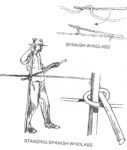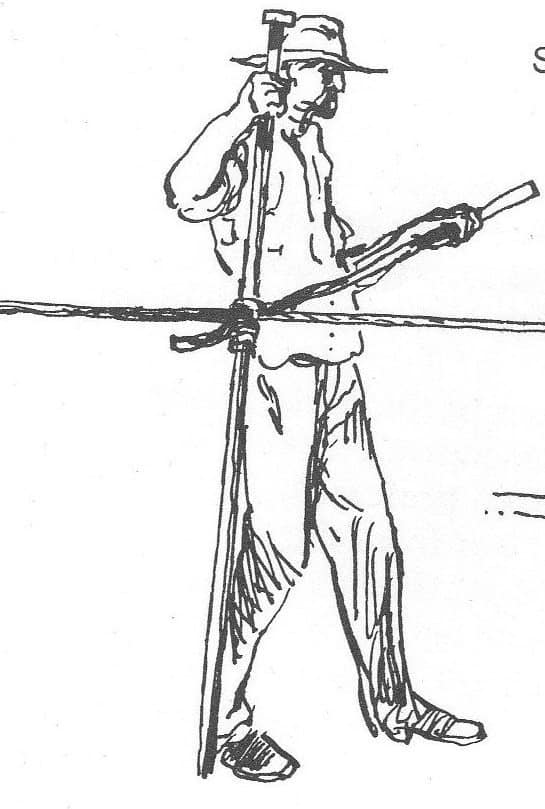My father, Lawrence used to use this trick sometimes to pull stumps out of the ground. He would wrap a rope around a crowbar (as shown) then wind the rope up with a stout branch. This windlass applied enormous force and was enough to pull quite large stumps out of a line of fence, for example. Of course you might need to shorten the rope a few times as it gets hard to turn after you have several loops around the bar.

I have ‘helped’ an old (late) friend Ray Quinney pull a flooded Land Cruiser from the Aberfeldy river with this method. It had inadvertently dropped into an ‘invisible’ deep hole in a river crossing we should probably not have been making. I thought it would need to be abandoned there and we would have to walk out. It took a while, but as we had no winch it was a godsend – well, a Ray-send actually! Then he took the glow plugs out, cranked the engine until all the water was out, restarted the truck and off we went again.

It is wonderful to have hunted, traveled and learned from such wonderful old bushmen. Ray was a Korean War veteran. He had lived and worked in the bush most of his life, a ‘jack-of-all-trades’. There was not much of a practical nature he did not know, from constructing his own house to rebuilding a bulldozer, distilling his own hooch, or operating a gold mine. You should also understand this: that such people who were willing to fight your battles for you, or able to rescue you from a tight spot in an emergency or fix the brakes on your car (and etc) were just as likely to be right with personal, financial and political advice too.
Those (much admired!) completely impractical ‘academics’ for example such as you meet at University who would run away from a man with a gun, and be dead in a day if left to their own devices in the wilderness – where your practical man would be enjoying himself and growing fat – are just as useless when it comes to personal, economic or political advice! See: http://www.theultralighthiker.com/the-compleat-survival-guide/ Alas, I only learned a fraction of what they had to teach before they were gone. Don’t make the same mistake yourself. Surround yourself with practical people, not armchair theorists – or worse still, keyboard warriors!

I have moved a log (that fell on the fence) with this method when neither the Land Rover nor the tractor could budge it. This goes to show how much force you can create. I have also used it to tighten a sagging fence (when I had no tools – see top illustration), to securely tie down a load on the back of the truck (and on Della’s roof rack just yesterday), and in its wire iteration, (The Cobb and Co Hitch) to secure innumerable things around the farm and ‘up the bush’.
It is a very useful piece of bush lore. You can also use it to hoist a heavy (deer) carcass up into a tree to ‘set’ overnight as I saw another (late) old friend Max Saunders do many years ago – when I was droving with him in the 60s. It was a cow we had killed for ‘rations’ on that occasion. Maybe you will one day find yourself in a tight spot (but having about you that piece of rope you always ought) will be able to use this wonderful mechanical invention to ‘save the day’.
A reader writes, ‘My uncle uses this arrangement to pull calves.‘ So many uses…
See Also:
http://www.theultralighthiker.com/bush-shower-mechanical-advantage/
http://www.theultralighthiker.com/wire-tricks-cobb-and-co-hitch/


I found a description of the Spanish Windlass in the book, Knots and Splices, by Percy W. Blandford–the best little book on knots that I know. I always wanted to try it out. One day, my friend Bill was clearing a foundation line for an addition to his house, and had a yard-diameter boulder in the line to remove. He did not want to bring in a tractor or other heavy machine that would tear up his grounds. He was futilely chipping away at the boulder with a chisel and sledge. I suggested we try the Spanish Windlass. He was very skeptical. I was uncertain. We used a six-foot iron rod as a standing pivot, and a pick handle to catch a loop of the rope and pry around the standing pivot. We pulled the boulder right out of the line in a few minutes. Based on the diameter of the wrap, about one inch, and the length of the pick handle, about 30 inches, I figured we applied a 30-fold force along the rope line.
They’re a great machine. Cheers, Steve.
My sailing mate used it to align 2 hulls of the catamaran we were repairing, with bolts in the beams. I was amazed. Then I remembered my father tightening new fencing wire at the corner post with this method.